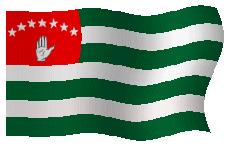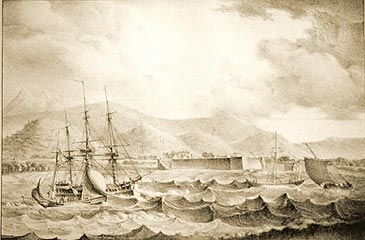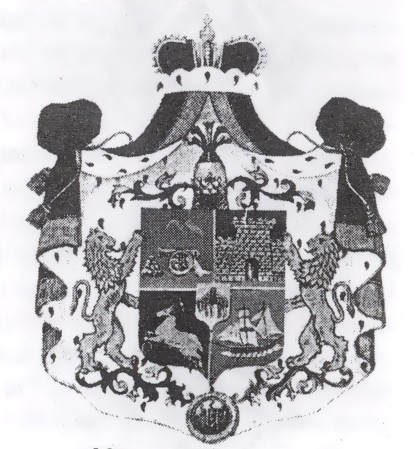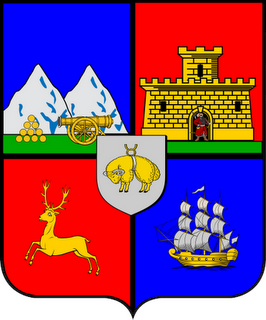MARSHAN FAMILY
ABKHAZIAN HISTORY PAGE
Please write to:
Please click on:
Our founding fathers lived like eagles

ANCHA ABAZARA & APSUWARA & AZAXGHARA YIWMIRDZIN

COATS OF ARMS OF MARSHAN PRINCES
LES ARMES DE PRINCES MARCHANIA
COATS OF ARMS OF MARSHAN PRINCES
Гербы князей МАРШЬАН - Маршан - Маршания
|
|
|
|

The Suhum Kale fort in the early 19th. Century
-----------------------------------------------------------------------------------------------------------------------------------------
ABKHAZIA, MARSHAN�A
Wikipedia, the Free Encyclopedia
The highlands of Tzabaldal 'center Abkhazia' (Tzebelda, Tsabal) were without any
centralized government, but were dominated by the clan of Marshania \
a'Marsan (Abk. Prince, Tavad). Marshania "Amarsan - Marsan" Family in
today's Turkey;
-----------------------------------------------------------------------------------------------------------------------------------------
ABKHAZIA
HISTORICAL OUTLINE
6th Century B.C
The Greeks established trading posts in Abkhazia, a Caucasian land, then known as Colchis at the Eastern end of the Black Sea. Their cities, especially Dioscurias (now modern day Sukhum) grew to be a prosperous trade center.
First Century B.C.
The Romans fortified Sukhum. The peoples' longevity was reported.
523 A.D.
Abkhazia became part of the Byzantine Empire. Christianity was adopted.
780 - 978
The Kingdom of Abkhazia flourished and the Abkhazia Dynasty extended its way over much of what is now Western Georgia.
1300-1500
A portion of Abkhazia was under the Mingrelian Rule
1500 - 1680
The Abkhazian Chachba Dynasty drove the Mingrelians out and established the boundaries that exist to this day.
1578
Abkhazia was invaded by the Ottoman Empire
18th Century
Abkhazia, in alliance with Georgia, made repeated efforts to drive out the Turks.
1801 - 1804
Various Georgian areas (Kartli and Kakhetia-1801, Mingrelia-1803, Imeretia and Guria-1804) came directly under Russian Rule (voluntarily seeking protection from Ottoman Turks and Iran).
1810
Tzar Alexander the First, issued a Charter to the ruling Prince of Abkhazia acknowledging Abkhazia as an autonomous principality under the protection of Russia.
1864
After prolong fighting across the entire region of the Caucasus, Abkhazia was the last Caucasian principality to be forcibly annexed to the Russian Empire. Russian oppression was so severe that over the next few decades more than half of the Abkhazian population fled to Turkey and the Middle East.
1917 - 1918
Abkhazia joined the Republic of North Caucasus. The Mensheviks took over the government of Georgia and succeeded in annexing Abkhazia.
March 1921
The Bolsheviks overthrew the Mensheviks in Georgia. The Abkhazian Soviet Socialist Republic was established separate from Georgia and headed by Nestor Lakoba.
1922
Abkhazia was a signatory to the formation of the USSR acting as a sovereign Abkhazian Republic.
1925
Abkhazia adopted its first Constitution under which it was united by a Special Treaty of Alliance with Georgia.
1931
Stalin (Georgian) and Beria (Mingrelian) reduced Abkhazia to the status of an autonomous Republic within Georgia.
1937 - 1953
Forced mass immigration into Abkhazia was carried out from Western Georgia (Mingrelia) by Stalin and Beria. In Abkhazia, as well as other regions of the USSR, mass oppression was carried out, thousands of intellectuals were persecuted. Abkhazian schools were closed. Abkhazians were punished for speaking their own language. The Cyrillic based Abkhazian script was replaced by one based upon the Georgian alphabet during this period.
1978
Abkhazian intellectuals signed a letter of protest to the Supreme Soviet of the USSR complaining about the status of Abkhazia and blamed the Georgian leaders for pursuing a "Beria" policy aimed at the "Georgianization" of the Republic. Major demonstrations at Lykhny (a sacred place in Abkhazian tradition) followed. The Abkhazian campaign, to be incorporated in the Russian Federation, was rejected by Russia and Georgia. Instead, concessions were made to the Abkhaz, including the opening of the University and TV broadcasting in Abkhazia. During that year (1978), Moscow allocated millions of rubles to help Abkhazia. The Abkhazian government never received the moneys. The sum was dispersed to restrain the Abkhazian people's protest at the existing conditions.
1988 - 1989
Leaders of the National Movement in Georgia demanded the abolition of the "Autonomies within Georgia along with the secession from the USSR
1989 - 1990
Georgian Soviet Socialist Republic unilaterally adopted a number of measures which essentially affected the secession of Georgia from the USSR and abregated all legal acts that united Georgia and Abkhazia under the Soviet power.
1990
On the eve of the signing of the new Soviet Union Treaty, Abkhazia, like all of the other autonomous Republics, declared its sovereignty. On the next day Georgia declared the abrogation of the Abkhazian Declaration of Sovereignty. Georgia abrogated the autonomy of Ossetia leading to the armed conflict between South Ossetia and Georgia.
1992
Abkhazia declares its sovereignty of its on territory and proposes a federative treaty to Georgia to fill in the "legal vacuum" that emerged after Georgia's unilateral abregation of all Soviet legal documents.
Exactly 20 days after being accepted by the United Nations, on August 14, Georgian troops entered the territory of Abkhazia without any notification to the Abkhazian government and launched a land and air attack on the southeast part of Abkhazia ant is capital city. Bloody fighting continued for 14 months.
1993
On September 30, Abkhazian forces - backed by the Confederation of the Peoples of the North Caucasus Organization finally ousted the Georgian troops from the territory of Abkhazia
1994
In April, joint Declaration of the Political Settlement was signed by the parties to the conflict - the UN, Russia and OSCE, in the presence of the UN Secretary General. The Declaration outlined principles for the peaceful settlement of the conflict on the basis of equality of the parties.
In May, negotiations under the auspices of the UN sanctioned the deployment of the CIS peace-keeping troops to separate the parties to the conflict.
November 26, Abkhazia ratifies its Constitution as a sovereign state.
Ref: http://www.abkhazia.org/history0.html
------------------------------------------------------------------------------------------------------------------------------------------
Principality of Abkhazia
From Wikipedia, the free encyclopedia
The Principality of Abkhazia emerged as a separate feudal entity in the
15th-16th centuries, amid the civil wars in the Kingdom of Georgia that
concluded with the dissolution of the unified Georgian monarchy. The
principality retained a degree of autonomy under the Ottoman, and then the
Russian rule, but was eventually absorbed into the Russian Empire in 1864.
Background
Abkhazia, as a duchy (saeristavo) within Georgia, was ruled by the clan of
Shervashidze (aka Sharvashidze, Chachba, or Sharashia) since the 12th century.
The sources are very scarce about the Abkhazian history of that time. The
Genoese established their trading factories along the Abkhazian coastline in the
14th century, but they functioned for a short time. When the Georgian kingdom
was embroiled in a bitter civil war in the 1450s, the Shervashidzes joined a
major rebellion against King George VIII of Georgia, which saw him defeated at
the hands of the rebels at Chikhori in 1463. As a result, Georgia split into
three rival kingdoms and five principalities. The Abkhazian princes were the
vassals of Mingrelia, which, in turn, was subordinated to the Kingdom of Imereti.
The vassalage was, however, largely nominal, and both Mingrelian and Abkhazian
rulers not only successfully fought for their independence, but contested
borders with each other and with Imereti.
The 16th-18th centuries
In the 1570s, the Ottoman navy occupied the fort of Tskhumi, turning it into the Turkish fortress of Suhum-Kale (hence, the modern name Sukhumi). Abkhazia came under the influence of Turkey and Islam, although Christianity was but slowly replaced and it was not until the second half of the 18th century that the ruling Shervashidze family embraced Islam. Until then, Abkhazia, secured from large-scale invasions by its mountainous location and impassable forests, had retained independence and profitted from commerce in traditional Caucasian commodities, that of slaves not excepted.
Throughout the 16th-18th centuries, the Abkhazian lords were involved in the
incessant border conflicts with the Mingrelian princes. As a result, the
Shervashidze potentates were able to expand their possessions in the east, first
to the river Ghalidzga, and then to the Inguri, which serves as today�s boundary
between Abkhazia and Georgia proper. After the death of the Abkhazian prince
Zegnak circa 1700, his principality was divided among his sons. The oldest
brother Rostom established himself as a prince of Abkhazia proper, also known as
the Bzyb Abkhazia, on the coast from the modern-day�s Gagra on the Bzyb River to
the Ghalidzga, with the residence in the village of Lykhny; Jikeshia received
Abjua between the Ghalidzga and the Kodori river; and Kvapu became a lord of a
county on the coast extending from the Ghalidzga to the Inguri, subsequently
known as the country of Samurzakan�o after Kvapu�s son Murzakan. The highlands
of Tzabaldal (Tzebelda, Tsabal) were without any centralized government, but
were dominated by the clan of Marshania. Sadzny,
formerly known as Zygia (Jiketi of the Georgian sources) extended north to
Abkhazia proper between the modern-day cities of Gagra and Sochi, and was run by
the Gechba clan. These polities included also several minor fiefdoms governed by
the representatives of the Shervashidze-Chachba house or other noble families
such as Achba (Anchabadze), Emhaa (Emukhvari), Ziapsh-Ipa, Inal-Ipa,
Chabalurkhua and Chkhotua. All these princedoms were more or less dependent on
the princes of Abkhazia proper.
Between the Ottoman and Russian empires
Keilash Bey seems to have been the first presiding prince of Abkhazia (circa
1780-1808) to embrace Islam, and was given, on this account, the fort of Suhum-Kale.
These conversions of the Abkhazian princes were, however, not irreversible;
during the 19th century, various Shervashidzes shifted back and forth across the
religious divide, as the Russians and Ottomans struggled for control of the
region. The first attempt to enter into relation with Russia was made by the
said Keilash Bey in 1803, shortly after the incorporation of eastern Georgia
into the expanding Tsarist empire (1801). After the assassination of this prince
by his son Aslan-Bey on May 2, 1808, the pro-Ottoman orientation prevailed but
for a short time. On July 2, 1810, the Russian Marines stormed Suhum-Kale and
had Aslan-Bey replaced with his rival brother, Sefer-Bey (1810-1821), who had
become converted to Christianity and assumed the name of George. Abkhazia joined
the Russian empire as an autonomous principality.
However, George�s rule, as well of his successors, was limited to the
neighbourhood of Suhum-Kale and the Bzyb area garrisoned by the Russians while
the other parts had remained under the rule of the Muslim nobles. The next Russo-Turkish
war strongly enhanced the Russian positions, leading to a further split in the
Abkhaz elite, mainly along religious divisions. During the Crimean War
(1853-1856), Russian forces had to evacuate Abkhazia and Prince Michael
(1822-1864) seemingly switched to the Ottomans. Later on, the Russian presence
strengthened and the highlanders of Western Caucasia were finally subjugated by
Russia in 1864. The autonomy of Abkhazia, which had functioned as a pro-Russian
�buffer zone� in this troublesome region, was no more needed to the Tsarist
government and the rule of the Shervashidze came to an end; in November 1864,
Prince Michael was forced to renounce his rights and resettle in Voronezh.
Abkhazia was incorporated in the Russian Empire as a special military province
of Suhum-Kale which was transformed, in 1883, into an okrug as part of the
Kutais Guberniya.
Aftermath
In July 1866 an attempt made by the Russian authorities to collect information
concerning the economic conditions of the Abkhaz, for the purpose of taxation,
led to a revolt. The rebels proclaimed the late Michael Shervashidze�s son
George as prince and marched on Suhum-Kale. Only the strong Russian
reinforcements led by General D. Sviatopolk-Mirskii were able to suppress the
revolt by the same August. The harsh Russian reaction led, subsequently, to a
considerable emigration of the Abkhaz muhajirs to the Ottoman empire, especially
after the locals took part in the rebellion of the Caucasian mountaineers
incited by the landing of Turkish troops in 1877. As a result many areas became
virtually deserted and the population of Abkhazia was reduced threefold.
Rulers
The lists of the early princes of Abkhazia are confused due to frequent breaks
in the succession, dynastic feuds, and foreign interventions as well as the lack
of recorded accounts. The senior branch of the Shervashidze/Chachba which ruled
Abkhazia proper/the Bzyb Abkhazia looks roughly as follows:
� Putu (circa 1580-1620)
� Seteman (circa 1620-1640)
� Sustar (circa 1640-1665)
� Zegnak (circa 1665-1700)
� Rostom (circa 1700-1730)
� Manuchar (circa 1730-1750)
� Zurab (circa 1750-1780)
� Keilash Ahmed-Bey (circa 1780-1808)
� Aslan-Bey (1808-1810)
� Sefer Ali-Bey (George) (1810-1821)
� Umar-Bey (Dmitri) (1821-1822)
� Michael (Hamud-Bey) (1822-1866)
See also
� Abkhazian Kingdom
� Caucasian War
� History of Georgia (country)
� Russian Empire
[edit] References and further reading
� (English) Alexei Zverev, Ethnic Conflicts in the Caucasus 1988-1994, in B.
Coppieters (ed.), Contested Borders in the Caucasus, Brussels: VUBPress, 1996
� Graham Smith, Edward A Allworth, Vivien A Law, Annette Bohr, Andrew Wilson,
Nation-Building in the Post-Soviet Borderlands: The Politics of National
Identities, Cambridge University Press (September 10, 1998), ISBN 0-521-59968-7
� Encyclopaedia of Islam
� (English) Center for Citizen Peacebuilding website
� (English) Conflicting Narratives in Abkhazia and Georgia. Different Visions of
the Same History and the Quest for Objectivity, an article by Levan
Gigineishvili, 2003
� (English) The Role of Historiography in the Abkhazo-Georgian Conflict, an
article by Seiichi Kitagawa, 1996
� Georgiy I Mirsky, G I Mirskii, On Ruins of Empire: Ethnicity and Nationalism
in the Former Soviet Union (Contributions in Political Science), Greenwood Press
(January 30, 1997) ISBN 0-313-30044-5
� Ronald Grigor Suny, The Making of the Georgian Nation: 2nd edition (December
1994), Indiana University Press, ISBN 0-253-20915-3
� Hugh Murray, The Encyclopaedia of Geography: Comprising a Complete Description
of the Earth, Physical, Statistical, Civil, and Political; Exhibiting its
Relation to the Heavenly Bodies, its Physical Structure, The Natural History of
Each Country, and the Industry, Commerce, Political Institutions, and Civil and
Social State of All Nations, Philadelphia: Blanchard and Lea, 1841, page 455
� The Oath of Allegiance of Prince Sefer-Bey to the Russian crown, August 23
1810 (Russian text)
------------------------------------------------------------------------------------------------------------------------------------------
Web Master: Hrips ypa a'Marshan "Mahmut Tugrul Kirmizi (Tatash)" (Ph. D. - I.T.U.)

------------------------------------------------------------------------------------------------------------------------------------------


